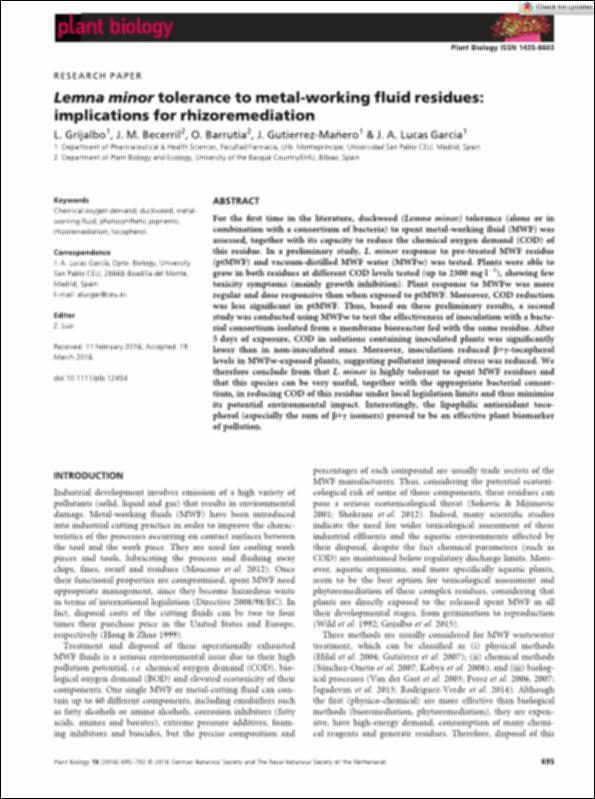Please use this identifier to cite or link to this item:
http://hdl.handle.net/10637/15968Lemna minor tolerance to metal-working fluid residues: implications for rhizoremediation
| Title: | Lemna minor tolerance to metal-working fluid residues: implications for rhizoremediation |
| Authors : | Grijalbo Fernández, Lucía Becerril, J.M. Barrutia, O. Gutiérrez Mañero, Francisco Javier Lucas García, José Antonio |
| Keywords: | Lentejas de agua; Pigmentos fotosintéticos; Vitamina E |
| Publisher: | Wiley |
| Citation: | Grijalbo L, Becerril JM, Barrutia O, Gutierrez-Mañero J, Lucas Garcia JA. Lemna minor tolerance to metal-working fluid residues: implications for rhizoremediation. Plant Biol (Stuttg). 2016;18(4):695-702. doi:10.1111/plb.12454 |
| Abstract: | For the first time in the literature, duckweed (Lemna minor) tolerance (alone or in combination with a consortium of bacteria) to spent metal-working fluid (MWF) was assessed, together with its capacity to reduce the chemical oxygen demand (COD) of this residue. In a preliminary study, L. minor response to pre-treated MWF residue (ptMWF) and vacuum-distilled MWF water (MWFw) was tested. Plants were able to grow in both residues at different COD levels tested (up to 2300 mg·l−1), showing few toxicity symptoms (mainly growth inhibition). Plant response to MWFw was more regular and dose responsive than when exposed to ptMWF. Moreover, COD reduction was less significant in ptMWF. Thus, based on these preliminary results, a second study was conducted using MWFw to test the effectiveness of inoculation with a bacterial consortium isolated from a membrane bioreactor fed with the same residue. After 5 days of exposure, COD in solutions containing inoculated plants was significantly lower than in non-inoculated ones. Moreover, inoculation reduced β+γ-tocopherol levels in MWFw-exposed plants, suggesting pollutant imposed stress was reduced. We therefore conclude from that L. minor is highly tolerant to spent MWF residues and that this species can be very useful, together with the appropriate bacterial consortium, in reducing COD of this residue under local legislation limits and thus minimise its potential environmental impact. Interestingly, the lipophilic antioxidant tocopherol (especially the sum of β+γ isomers) proved to be an effective plant biomarker of pollution. |
| URI: | http://hdl.handle.net/10637/15968 |
| Rights : | http://creativecommons.org/licenses/by-nc-nd/4.0/deed.es Open Access |
| ISSN: | 1435-8603 |
| Issue Date: | 23-Mar-2016 |
| Center : | Universidad San Pablo-CEU |
| Appears in Collections: | Facultad de Farmacia |
Items in DSpace are protected by copyright, with all rights reserved, unless otherwise indicated.


